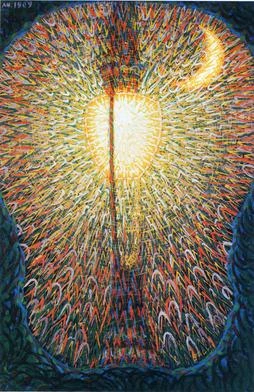What type of art was created during the Futurist art movement?
Paintings, mixed media sculptures and literature were produced bearing themes of the Futurist art movement.
Futurism art was created and popular during which years?
Futurism or the Futuristic art movement was roughly popular between 1912 to 1920.
Where was Futurism art made and popularised?
Italy and other parts of Europe are where Futurism artworks were made and popularised. Later on, an amalgamation of Cubism, Purism and Futurism together brought about the Percisionism art movement in America.
Who are some famous Futurism artists and artworks?
Ascending Forms (or Ascending Forces) by Gerardo Dottori

Ballerina in Blue by Gino Severini

Street Light by Giacomo Balla

Interesting observations about the Futurist art movement – Art Op-Ed
The “Realism” art movement was where artists chose to paint a subject exactly as it was in reality. “Romanticism” as the name would suggest, is where artists painted a romanticised version of the subject. Just like these art movements enabled artists to have a particular rendition of the subject, Futurism was one such movement. “Futurism” eponymously depicted futuristic interpretations of the subject that was painted or sculpted. However, just like “Back to the Future” thought we would have flying cars by 2015, the artists in the 1920s painted what they thought was futuristic.
If the Futurism art movement were to be revived today, the paintings might just look extremely different. This is simply because artists today would have a very different definition of what they feel is “futuristic” than the artists in the 1920s. This would make the Futurist movement morph into something totally different with every possible revival.
Which art movement(s) came before the Futurist movement?
Surrealism and Early Modernism were the art movements that came before the Futurist movement
Which art movement(s) came after the Futurist movement?
Postmodernism came after the Futurism art movement.
Top 8 artworks from the Futurism Art Movement:
“Unique Forms of Continuity in Space” – Umberto Boccioni (1913):

Umberto Boccioni’s sculpture “Unique Forms of Continuity in Space” is the epitome of the dynamic and forward-looking spirit of Futurism. The artwork captures the essence of movement, portraying a striding figure with aerodynamic, abstract forms. Boccioni sought to convey the modernity, speed, and vigour of the machine age, reflecting the Futurist fascination with technology.
“Dynamism of a Soccer Player” – Giacomo Balla (1913):

Giacomo Balla, another prominent figure in the Futurist movement, expressed the dynamism of modern life through his painting “Dynamism of a Soccer Player.” The artwork captures the rapid movements of a soccer player on the field, utilising fragmented shapes and a sense of kinetic energy. Balla’s fascination with speed and motion is palpable, reflecting the Futurist manifesto’s emphasis on capturing contemporary dynamism.
“Interventionist Demonstration” – Carlo Carrà (1914):

Carlo Carrà’s “Interventionist Demonstration” is a powerful depiction of the socio-political undercurrents of the Futurist movement. Created during World War I, the painting portrays a chaotic and fragmented scene of activism in the streets. Carrà’s work reflects the Futurist commitment to social and political activism, as many of its members were enthusiastic supporters of Italian intervention in the war.
“Simultaneous Visions” – Umberto Boccioni (1911):

Boccioni’s “Simultaneous Visions” exemplifies the Futurist interest in capturing multiple perspectives simultaneously. The artwork presents a fragmented and abstract depiction of a woman’s face, as if viewed from different angles simultaneously. This exploration of simultaneity and the disintegration of form was a recurring theme in Futurist art.
“The City Rises” – Umberto Boccioni (1910-1911):

“The City Rises” by Boccioni is a monumental painting that encapsulates the Futurist fascination with urban life. The artwork portrays a dynamic cityscape undergoing transformation, with humans and machines merging into a frenzied energy. Boccioni’s use of fractured forms and vibrant colours captures the pulsating vitality of the modern metropolis.
“The Charge of the Lancers” – Gino Severini (1915):

Gino Severini’s “The Charge of the Lancers” is a vibrant portrayal of the chaos and intensity of war. Severini, influenced by both Futurism and Cubism, employs fragmented geometric shapes and bold colours to depict the dynamic charge of lancers. The painting captures the brutality and energy of battle, reflecting the Futurist movement’s engagement with the themes of war and conflict.
“Synthesis of Human Dynamism” – Giacomo Balla (1916):

Giacomo Balla’s “Synthesis of Human Dynamism” combines elements of Futurism with a distinctive personal style. The painting features abstract, kaleidoscopic forms that convey a sense of energy and movement. Balla’s work represents the Futurist interest in capturing the dynamism of the human experience in a rapidly changing world.
“States of Mind” Series – Umberto Boccioni (1911-1912):

Boccioni’s “States of Mind” series comprises three paintings—”The Farewells,” “Those Who Go,” and “Those Who Stay.” Each artwork explores the emotional and psychological states of individuals in different moments of daily life. Through fragmented forms and dynamic compositions, Boccioni delves into the subjective experiences of his subjects, embodying the Futurist interest in capturing the complexities of modern consciousness.
The Futurist art movement, born in the early 20th century, left an indelible mark on the trajectory of modern art. The artworks mentioned above, created by influential Futurist artists, exemplify the movement’s core principles—capturing movement, dynamism, and the spirit of the machine age. These masterpieces continue to be celebrated for their innovation, bold experimentation, and their role in shaping the visual language of the modern era.
*Images from Wiki Commons







0 Comments